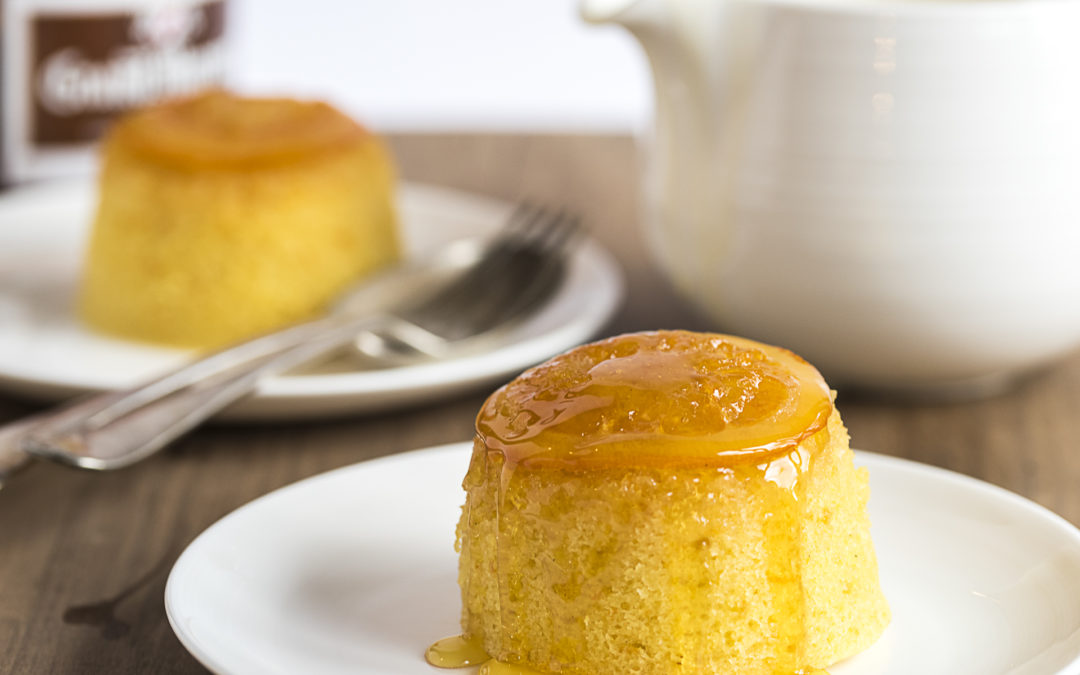Nursery puddings are always popular, especially treacle sponge – if they’re not amongst the first things we eat then sponges are one of the first things we learn to cook. Fortunately, unlike the jam tart, it’s perfectly acceptable to enjoy a steamed sponge well into adult life and still maintain one’s dignity.
This orange treacle version is particularly grown up, with the inclusion of candied orange as a decorative topping and a generous slug of Grand Marnier in the custard sauce.
The slice of orange nestled in sticky syrup on top of the upturned puddings really elevates the dish, but it will add another hour of prep’ as you wait for the orange to ‘candy’. The orange wouldn’t cook sufficiently if you missed out this stage as the puddings only take 35 mins in the oven, but the upside is candying the orange will also leave you with an intensely orange syrup to add to your custard. If you’re short of time, miss out the orange decoration altogether and proceed as per the recipe.
It’s also possible to swap the orange for lemon, working on the rough basis that 2 small lemons equals 1 orange. You may also miss out the Grand Marnier from the custard should you have reason to.
Ingredients
(makes 6 individual puddings)
For the candied orange
1 x orange (tennis ball size)
200g caster sugar
For the puddings
130g caster sugar
130g softened butter
2 x large eggs, lightly beaten with a fork
1 x teaspoon baking powder
130g plain flour
Finely grated zest of 1 orange + juice
For the custard
300 ml double cream
200ml semi skimmed milk
2 x egg yolks
2 x teaspoons cornflour
Finely grated zest of 1 orange
2 x tablespoons Grand Marnier
Preheat the oven to 180⁰C
Slice the orange as thinly as you can; add six slices to a small pan, cover with cold water and bring up to the boil. Drain the orange slices into a sieve and discard the water.
Add the sugar to the pan along with 400ml of water, place over a medium heat and stir to dissolve. Bring the syrup up to a gentle simmer and add back the orange slices. Poach gently in the syrup for 1 hour. Drain again through a sieve, reserving the syrup in a bowl.
Butter the insides of the pudding basins and add a generous covering of golden syrup to the base of each. Add a slice of orange to each one (make a cut through the rind to the centre of the slice if they’re too big to fit into the base and overlap it to fit neatly).
Cream the butter with the sugar until light and fluffy, then slowly add the egg a little at a time. Once all the egg is beaten in thoroughly, fold in the flour along with the baking powder and the grated orange zest. Add the reserved orange juice to loosen the sponge mix, a little at a time until you have a good dropping consistency.
Fill the kettle and put it on to boil.
Divide the sponge mix between the pudding basins and roughly level the tops with the back of a teaspoon.
Stand the basins in a deep roasting tin and fill with recently boiled water to half way up the sides. Cover the whole thing with a double layer of foil, sealing the edge tightly but being careful not to pull the foil too tight and restrict the sponges from rising.
Steam the puddings in the oven for 35 mins, then check with a cocktail stick – which should come out clean and dry when inserted into the centre of the puddings. Remove them to a wire rack and let them cool for 5 mins before running a knife gently around the inside of each basin and then turning them out.
To make the custard, gently heat the milk with the cream and infuse with the grated orange zest for at least half an hour, preferably longer. Strain the milk through a sieve to remove the orange zest, then bring back to just below simmering point in the pan.
Beat the egg yolks with the caster sugar and cornflour, then slowly dribble in the hot milk, stirring as you go. Pour the custard back into the milk pan and stir over a low heat for 5 – 10 minutes until thickened and coating the back of a spoon. Add the Grand Marnier if using and stir for another minute.
Remove from the heat and add 2 tablespoons of the reserved poaching syrup.
If not serving immediately, the custard can be reheated either in a bowl sat over a pan of simmering water, or very, very gently in the microwave.

